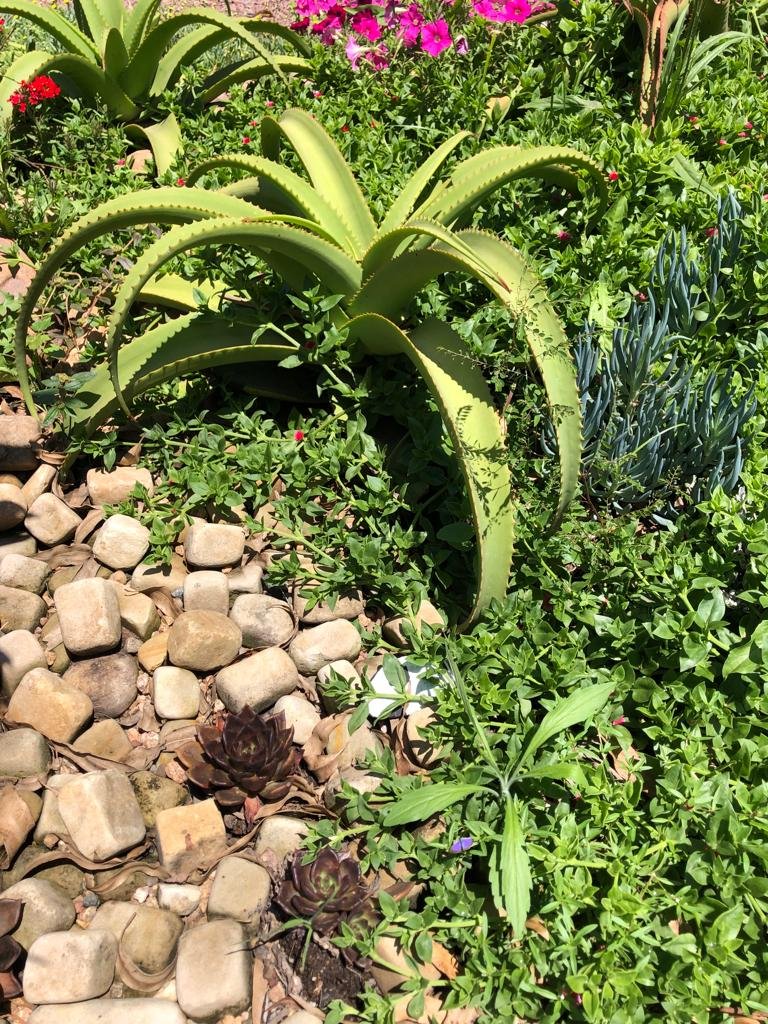Add an extra element to your garden by placing wildlife on your garden maintenance agenda. Not only do birds, bees, and butterflies bring your garden to life, your outside space can provide them with a conservation haven.
Autumn: To Do's In Your Garden
AUTUMN TO-DO’s IN YOUR GARDEN
Inspect your garden and surrounds for alien weed invaders: if you have not been looking too closely alien invaders are alive and well in your garden! The ideal hot summer conditions we have been having are ideal for alien weed invaders to thrive and start overtaking. By removing them urgently asisit to break the invasive cycle.
Observe how the growth of the plants in your garden have begun to slow down now and many start to withdraw chlorophyll from their leaves, displaying an exquisite array of warm autumn colours .Plants that are chosen for their winter character and winter flowering here on the coast amongst others are: flowering Red hot Pokers( Knifophia), Aloes, Plectranthus, Crane flowers, Bulbine, Ribbon bush and succulent leaves like Cotyledons that become intense in colour.
Enjoy walking around your garden and appreciate a new season .
Check your irrigation system . Take some time to run your irrigation system and inspect for any repairs that may be needed.Check each spray head and ensure that it is dispersing water correctly and is facing in the right direction...watering the wall or driveway is not a good idea. Be water wise and check for any leaks or breaks in your pipe. These are easy to repair.
Reset your irrigation controller to your autumn program. A deep watering three times a week is far better than a short watering daily.
Think of your own or your garden helpers watering habits, would it be wiser to invest in a system that delivers the correct amount of water and on schedule?It is a know fact that a garden irrigated by a well-designed irrigation system uses less water per month than a garden watered at the same intervals by hand.
Install a water storage tank as traditionally our rainfall reduces now. This is the time when one leans heavily on stored water for the irrigation system to keep our lawn and gardens well watered and looking good throughout autumn and winter.
Small Garden Ideas: Landscape Design Must Have Privacy Screening
Veggie and Herb Pots
Lighten Up
 Well placed garden lighting can add an interesting dimension and transform your garden after sunset. We love and nurture our gardens during the day but tend to disappear indoors as soon as the sun sets. Lighting will not only extend the time spent in the garden, but can also highlight garden features, special plants and walkways as well as create an enchanting mood and keeping your home secure.
Well placed garden lighting can add an interesting dimension and transform your garden after sunset. We love and nurture our gardens during the day but tend to disappear indoors as soon as the sun sets. Lighting will not only extend the time spent in the garden, but can also highlight garden features, special plants and walkways as well as create an enchanting mood and keeping your home secure.
Courtyard Lighting
Energy Saving Lighting
Energy saving is always the top of our list to suit our pocket and also to aid in saving our environment .The ideal energy saving products to use are LED lamps which have a very low consumption of power and long life globes for cost effective maintenance. Solar lights are the ultimate in electricity saving. They are also easy to install. The brightness of the light is determined by the wattage of the LED's and their quality. Consider carefully where the solar lights are placed; they need at least four hours of direct sunlight to run optimally at night.
A fibre optic system and LED strips are another energy saving option. They are safe to use around water features.
Whether you decide on electricity or solar power to lighten up your life, remember the key to successful garden lighting is a soft and subtle approach. A few well chosen fittings positioned creatively are all you need to enjoy your enchanting garden once the sun has set.
Positioning Your Lights
Before deciding on lighting positions, arm yourself with a torch and set off for a night's walk around the garden to see what you'd like to illuminate. You may have a significant tree, a specimen plant or cycad, a pathway, water or garden feature that would look magnificent with the right lighting.
 Part of the garden lighting design process is about choosing and applying creative garden lighting effects to these especially selected areas. There is a fine line between creating an "atmosphere "by using lighting verses creating a GLARE. So to keep on the "atmosphere" side of the line, consider the following before positioning your lights:
Part of the garden lighting design process is about choosing and applying creative garden lighting effects to these especially selected areas. There is a fine line between creating an "atmosphere "by using lighting verses creating a GLARE. So to keep on the "atmosphere" side of the line, consider the following before positioning your lights:
- Down lighting accurately lights the intended subject without much wasted light
- Consider your neighbours when positioning up lighters
- Link you lights to a timer, which ensures a welcome and safe arrival after sunset and considerate to all after bed time.
- Place light fixtures low to the ground to illuminate pathways and steps, which will make them more attractive and provide a safer well lit, walk way.
- Conceal light fittings behind foliage, plants or rocks, this adds to the magic of lighting.
- Adjust the angle of the light until you have found the ideal positioning.
- Avoid excessive brightness near seating areas.
- Avoid light pollution also known as photo pollution or luminous pollution by concentrating on the effect being soft and subtle.
- A practical idea would be to draw a plan so that in years to come you will know exactly where cables have been placed and alert all people who work in your garden to their location.
Lawn Tips
Give your lawn a last feed before winter, to help it through. Mow your lawn only when you need to and remember to raise the blades on your mower. You only ever want to mow one third of the leaf off at a time. Any more than that will cause large brown patches. WHAT'S HOT:Feeding your soil with compost and fertiliser
WHAT'S NOT:Planting water thirsty plants where they get the hot afternoon sun
Transplanting Tips
 If you need to relocate established trees and shrubs to a more suitable position in your garden, Autumn is the best time to do it.
Tip 1: In preparation for the big move, always prune trees and shrubs before digging them out, this helps to minimize transplant shock, this gives them a much better chance to make a rapid recovery in their new home.
If you need to relocate established trees and shrubs to a more suitable position in your garden, Autumn is the best time to do it.
Tip 1: In preparation for the big move, always prune trees and shrubs before digging them out, this helps to minimize transplant shock, this gives them a much better chance to make a rapid recovery in their new home.
Tip 2: Prepare the new hole before you even start digging the tree or shrub out. Good hole preparation is key. A general rule for a medium sized tree (of about a man's height) is to dig a 1m x 1m hole and about 800mm deep. Now that is a lot of digging, but worth the effort when you see your tree flourishing. Mix the soil that has come out of the hole with generous amounts of compost, bone meal and a general fertilizer.
Tip 3: Very important when transplanting any plant, is to firmly compress the soil around the roots of the plant. You can really be quite tough about it. Even a great big stomp with your garden boots is good. Large air pockets around the roots cause the fine root hairs to dry out and causes the death of the plant.
Tip 4: The "Life and Death" tip: Never plant your tree too deep in the hole. If soil covers the stem of your tree, higher than what it was in its original position... IT WILL DIE.










